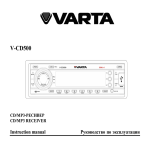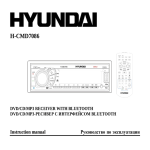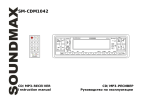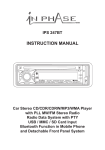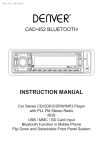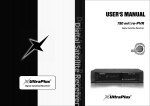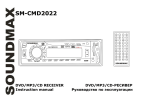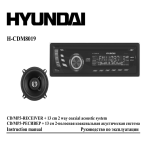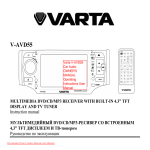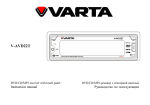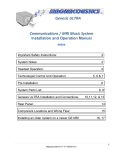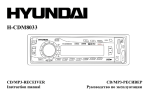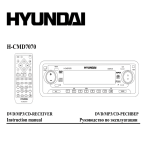Download Инструкция Автомагнитола Hyundai h
Transcript
H-CDM8035 CD/MP3/WMA RECEIVER Instruction manual CD/MP3/WMA- Dear customer! Thank you for purchasing our product. For safety, it is strongly recommended to read this manual carefully before connecting, operating and/or adjusting the product and keep the manual for reference in the future. Table of contents Table of contents............................................................................................................................................................................... 2 Important safeguards......................................................................................................................................................................... 3 Accessories ....................................................................................................................................................................................... 4 Installation/Connections .................................................................................................................................................................... 5 Controllers ........................................................................................................................................................................................ 9 General operations .......................................................................................................................................................................... 12 Radio operations ............................................................................................................................................................................. 14 CD/MP3/WMA/USB/SD/MMC card operations.............................................................................................................................. 17 MP3/WMA overview ...................................................................................................................................................................... 21 Handling compact discs................................................................................................................................................................... 23 Cleaning ......................................................................................................................................................................................... 23 Troubleshooting guide..................................................................................................................................................................... 24 Specification ................................................................................................................................................................................... 25 2 Important safeguards Read carefully through this manual to familiarize yourself with this high-quality sound system. The beginning of operation is the moment of the unit installation. Before use the device in winter it is recommended to heat up the passenger compartment during 20 seconds or to the operation temperature. Use the unit with the temperature that goes beyond the operation temperature greatly decreases the operation resource of the screen and other components of device and can result an outage. Disconnect the vehicle's negative battery terminal while mounting and connecting the unit. When replacing the fuse, be sure to use one with an identical amperage rating. Using a fuse with a higher amperage rating may cause serious damage to the unit. Do not attempt to disassemble the unit. Laser beams from the optical pickup are dangerous to the eyes. Make sure that pins or other foreign objects do not get inside the unit; they may cause malfunctions, or create safety hazards such as electrical shock or laser beam exposure. Do not use the unit in places where it can be exposed to water, moisture and dust. Do not open covers and do not repair yourself. Consult the dealer or an experienced technician for help. Make sure you disconnect the power supply and aerial if you will not be using the system for a long period or during a thunderstorm. Make sure you disconnect the power supply if the system appears to be working incorrectly, is making an unusual sound, has a strange smell, has smoke emitting from it or liquids have got inside it. Have a qualified technician check the system. The unit is designed for negative terminal of the battery, which is connected to the vehicle metal. Please confirm it before installation. Do not allow the speaker wires to be shorted together when the unit is switched on. Otherwise it may overload or burn out the power amplifier. 3 Accessories 1. 2. 3. 4. 5. 6. 7. 8. 9. Receiver Remote controller Front panel Carrying case ISO connector Mounting parts: Hexagon nut M5 T Mounting box Release keys Metal bar Plain washer Outer trim ring Spring washer Screw (5X25 mm) Screw M5 (5X29.3 mm) Customer information Warranty card Instruction manual 1 pc 1 pc 1 pc 1 pc 1 pc 1 pc 1 pc 2 pcs 1 pc 2 pcs 1 pc 2 pcs 1 pc 1 pc 1 pc 1 pc 1 pc 4 Installation/Connections Choose the mounting location where the unit will not interfere with the normal driving function of the driver. Before finally installing the unit, connect the wiring and make sure that the unit works properly. Consult with your nearest dealer if installation requires the drilling of holes or other modifications of the vehicle. Install the unit where it does not get in the driver's way and cannot injure the passenger if there is a sudden stop, like an emergency stop. If installation angle exceeds 30° from horizontal, the unit may not perform properly. Avoid installing the unit where it would be subject to high temperature, such as from direct sunlight, or from hot air, from the heater, or where it would be subject to dust, dirt or excessive vibration. Din Front/Rear-Mount This unit can be properly installed either from 'Front' (conventional DIN Front-mount) or 'Rear' (DIN Rear-mount installation, utilizing threaded screw Holes at the sides of the unit chassis). For details, refer to the following illustrated installation methods. DIN FRONT-MOUNT (Method A) 1. Car dashboard 2. Sleeve 3. Screw 4. Nut 5. Spring washer 6. Screw 7. Metal strap 8. Flat washer 5 1. 2. 3. 4. 5. Install the sleeve into the dashboard; ensure it is installed with the correct side and there are no obstacles (wires, dashboard elements, etc) for the unit installation. After installing the sleeve into the dashboard, bend tabs fitting to the size of the dashboard to fix the sleeve in place. Use the metal strap to fix the rear side of the unit. Determine a place for fixing and install the strap as shown in the picture. You can bend the strap to the needed angle with your hands. Make the necessary wire connections. Ensure the connections are correct. Install the unit into the sleeve until the side locks are fixed. Dismantling the unit – Trim frame – Frame uninstall direction – Release key insertion 1. 2. 3. Switch off the unit and detach the front panel. Insert your fingers into the groove in the front side of the trim frame (apply some effort to detach the frame). Pull the frame to detach it. Insert the supplied release keys into the both sides of the unit body to click, as shown in the picture. To extract the unit from the dashboard, pull the release keys or the unit body to pull it out. Before detaching the unit, ensure it is not fixed with the metal strap. Trim frame installation To install the trim frame, press it to the unit body and push it to fix it in place. This should be done before installing the front panel; otherwise you are not able to install the trim frame. When the trim frame being installed, the side with the groove should face down and fixed first. 6 2. DIN REAR-MOUNT (Method B) For this method, use the screw holes in the lateral sides of the unit. Fix the unit with the help of the factory radio mounting brackets. 1. Select a position in which the screw holes of the brackets (3) are aligned with the screw holes in the unit body, and screw in two screws (2) in each side. 2. Screw. 3. Factory radio mounting brackets. 4. Vehicle dashboard. 5. Lock (remove this part). Note: The outer trim frame and mounting sleeve are not used for method of installation. Installing the front panel Insert the right side of the panel, and then press on the left side until the click. To detach the front panel, press REL button. Anti-theft system The front panel of this unit can be stored in the included protective case when not in used and carried away when you leave the vehicle to deter theft. Switch off the power of the unit. Detach the front panel, then put it to the protective case and take it with you. Caution: The control panel can easily be damaged by shocks. After removing it, place it in a protective case and be careful not to drop it or subject it to strong shocks. The rear connector that connects the main unit and the control panel is an extremely important part. Be careful not to damage it by pressing on it with fingernails, pens, screwdrivers, etc. Note: If the control panel is dirty, wipe off the dirt with soft, dry cloth only. And use a cotton swab soaked in isopropyl alcohol to clean the socket on the back of the control panel. 7 Connection diagram ISO speaker connection Notes: In spite of having any kinds of speaker system, must use 4 ohms impedance of speaker to reduce the distortion during high volume level. Prohibited to make the conductors of auto antenna and ground touch with each other. 8 Controllers Front panel 1. 2. 3. 4. 5. 6. 7. 8. 9. 10. 11. 12. 13. 14. 15. 16. 17. 18. 19. 20. 21. 22. 23. REL button TA button AF button PTY/CLK button BND/SUB buttons 1/PLAY/PAUSE button 2/INT button 3/RPT button 4/RDM button 5/DN10 button 6/UP10 button F/PS button AUX IN USB socket IR sensor SD/MMC socket EJECT button Disc slot LCD display VOL knob/SEL button POWER button MODE button PREV/NEXT buttons 9 Back of the front panel Press REL button to detach the panel. 3 1. 2. 3. Panel status indicator RESET button (hole) Disc slot 2 Note: Pressing RESET button (hole) will erase the clock setting and stored stations. Panel status indicator lights up when you slide the panel down, flashes when you remove the panel. 10 1 Remote control (RC) 1. 2. 3. 4. 5. 6. 7. 8. POWER button VOL+/VOL-, NEXT/PREV, SEL buttons BAND button APS button MODE button 1/PLAY/PAUSE button 2/INT button 3/RPT button 4/RDM button 5/DN10 button 6/UP10 button RDS buttons: TA button AF button PTY button MUTE button CLK button 11 General operations Power button Press any button on the RC or on the unit (except REL and EJECT buttons) to switch the unit on. The display will show a message “WELCOME”. Press and hold POWER button to switch the unit off. The display will show a message “GOODBYE”. Note: After the unit is off, volume level and radio current settings will be memorized, and when you turn the unit on it will resume the stored status you set. Volume control Rotate VOL knob on the faceplate. The larger the number shown on the display, the higher the volume level is. Or press VOL+/VOLbuttons on the RC. Sound settings Press SEL button shortly and repeatedly to select the mode: VOL => BAS => TRE => BAL => FAD => LOUD => LOC => ST => EQ=> BEEP=> COLOR 1. Rotate VOL knob or use VOL +/VOL- buttons to adjust each mode. VOLUME: 00, 02,......, 39 BASS/TREBLE: -7, -5,......, 0, +1, +2,......+5, +7 BALANCE: 7L,......, 7R FADER: 7R,...., 7F LOUD: ON/OFF LOC: LOC ON, LOC OFF (DX). ST: ON, OFF BEEP: ON/OFF EQ: CLASS, POP, ROCK, FLAT, OFF COLOR: COLOR1, COLOR2 (to select the needed backlight color). Note: In each mode, the waiting time is about 5 seconds, and the waiting time is over, it returns to the last display mode of radio or disc playback mode. 12 Mode selection Press MODE button on the RC to cycle the play mode: AUX => RADIO => DISC => USB => CARD. Note: USB, CARD, DISC mode will only show on the display when a USB flash memory is inserted into the USB port. Mute function Press MUTE button to cancel the sound. Press it again or adjust the volume level to resume the sound. Subwoofer control Press and hold BND/SUB button or BAND button on the RC to turn the subwoofer output on. An external amplifier is required to operate a subwoofer. Clock setting The clock can be set anytime when the power is on. Press three times CLK button on the RC or press PTY/CLK button on the unit, then press and hold the button for 3 seconds; the time indication will blink on the display. Rotate VOL knob or press VOL+/VOLbuttons on the RC to adjust hours. Press SEL button to go to setting minutes. Rotate VOL knob or press VOL+/VOL- buttons on the RC to adjust minutes. Press CLK button on the RC or PTY/CLK button on the unit for the new setting to take effect. Press CLK button on the RC or PTY/CLK button on the unit anytime to view the time display. 13 Radio operations BAND selection Press repeatedly BND/SUB button or BAND button on the RC to select your desired radio band in radio mode: FM1, FM2, FM3, AM1 (MW1), AM2 (MW2). Each band can store 6 preset stations, for a total of 30 preset memory stations. Tuning Press PREV/NEXT buttons to manually adjust the radio frequency. Press and hold PREV/NEXT buttons, the radio will seek to the next up or down strong and clear frequency station automatically. Repeat this action to seek for other desired stations. Automatic store/Scan Automatic store: Press and hold F/PS button, the receiver will automatically scan and save stations for the current band. Scan: Press F/PS button once to scan the saved stations. Note: To perform this operation, you can also use APS button on the RC. Programming stations You can store up to a total of 30 radio stations in the memory (18 FM, 12 AM (MW)). To store a station: Select a band. Select a station. Press and hold a numbered button (1-6) under which you want to store the station. To recall a station: Select a band. Press a numbered button (1-6) briefly to recall the corresponding stored station. RDS function Note: RDS (Radio Data System) service availability varies with areas. Please understand if RDS service is not available in you area, the following service is not available, either. 14 Function AF (Alternative frequency) Briefly press AF button to turn on or turn off the AF function. Symbol “AF” will appear on the display. The tuner will return to Alternative Frequencies whenever the reception signal is getting worse. AF symbol is on – the AF mode is on, RDS information is being received; AF symbol is off – the AF mode is off; AF symbol is flashing - the AF mode is on, RDS information is not being received. Function TA (Traffic announcement) Press TA button briefly to select the TA mode on/off. Traffic announcement interrupts CD playback or radio listening when broadcasted. To interrupt traffic announcement press TA button shortly; it will not switch off the TA mode. The set will return to the previous operating mode. PTY function Press PTY/CLK button on the panel or PTY button on the RC to show the music type. Then press 1-6 button to choose different music programs available. Press the button twice to show the speech type program. Then press 1-6 button to choose different speech programs. Each number button will show 3 different speech programs for you to choose (see table below). MUSIC 1. 2. 3. 4. 5. 6. SPEECH POPM, ROCK M EASY M, LIGHT M CLASSICS, OTHER M JAZZ, COUNTRY NATION M, OLDIES FOLK M 1 2 3 4 5 6 15 NEWS, AFFAIRS, INFO SPORT, EDUCATE, DRAMA CULTURE, SCIENCE, VARIED WEATHER, FINANCE, CHILDREN SOCIAL, RELIGION, PHONE IN TRAVEL, LEISURE, DOCUMENT Other parameter setting To choose the corresponding parameter, press and hold SEL knob for 2 seconds, and then press it repeatedly until the display shows the parameter. Turn VOL knob or press VOL+/VOL- buttons on the RC to choose the needed value. After choosing, please leave the unit idle to activate. TA SEEK/TA ALARM In TA SEEK mode, the unit will seek for traffic announcement program when TA is pressed; in TA ALARM the unit does not retune to TA information. MASK DPI/MASK ALL During MASK DPI mode, the unit will mask only the AF which has different PI, this is the default mode; during MASK ALL mode, the unit will mask the AF which has different PI and no RDS signal with high field strength. RETUNE S/L - SHORT/LONG “RETUNE” refers to the time period the unit allows for radio scan when reception is interrupted. “S” represents a long time period and “L” represents a short time period. 16 CD/MP3/WMA/USB/SD/MMC card operations Discs for playback This unit can play disc types: CD/CD-R/-RW. Compatible with formats: MP3/WMA. USB/SD/MMC notes USB functions (flash memory type) MP3 music play. SD/MMC card support, 2in1 (SD/MMC) support. USB flash memory. FAT 12/ FAT 16/ FAT 32 is possible FAT 12/16 (dir: 200 support, file: 500 support), FAT 32 (dir: 200 support, file: 500 support). Filename: 32 byte/ Dir name: 32 byte. Tag (id3tag ver2.0). Title/ Artist/ Album: 32 byte support. Multi card reader not support. USB 2.0 support. Notes: USB format supports 2.0. Capacity: 8 MB ~ 1 GB. SD cards brands: Canon, Fuji film, Palm, Motorola, Microsoft, IBM, HP, Compaq, Sharp, Samsung, etc. Capacity: 8 MB ~ 1 GB. MMC cards brands: Ericsson, Nokia, Motorola, HP, Palm, Sanyo, Microsystems, etc. Capacity: 16 MB ~ 1 GB. Loading/Eject a disc Insert the disc with the printed side facing upward into the slot. The word “LOAD” will be displayed and the CD will play automatically. As the file is playing MP3/WMA will be displayed first, then if there is any ID3 information that will be displayed as the file is playing. Press EJECT button to eject the disc. If the disc is not removed from the slot within 10 seconds, it will automatically be loaded into the slot again. When the disc is ejected and removed, the unit will automatically switch to radio mode. 17 Multi-session CD reading The multi-session reading will be activated automatically if the player detects a file that is written in a compatible format. Inserting the USB/SD device Insert the MMC/SD card or USB device into MMC/SD compartment or USB socket. Then the playing mode will be changed into MMC/SD or USB mode automatically. The first card/USB device track playback will start. Note: When MMC/SD card and USB device are both inserted into their compartment or socket, the playing mode will be changed into the mode of the later one. Pausing playback To ensure good system performance, wait until the unit finishes reading the disc information before proceeding. Press 1/PLAY/PAUSE button to pause the playback. Press again to resume the playback. Playing the previous/next track During playback press NEXT/PREV buttons to play the previous/next track. Track numbers will be shown on the display. Fast forward and backward playback Press and hold NEXT/PREV buttons more than 3 seconds to fast forward or reverse. Release the button when the desired location is found. UP 10/DN 10 function (for MP3, WMA modes) Press 6/UP 10 button to advance 10 track at a time. Press 5/DN 10 button to go back 10 track at a time. Repeat playback During disc playback, press 3/RPT button to repeat the current track playback. The display will show “RPT”. Press again to cancel. During playback the MP3/WMA format press 3/RPT button to choose track repeat, folder repeat or repeat off. Random playback During disc playback, press 4/RDM button to start random playback of the tracks. 18 The display will show “RDM”. Press again to cancel. Intro playback You can play the beginning of every track for 10 seconds in sequence. Press 2/INT button to start intro play. The display will show “INT”. Press again to cancel. ID3 Tag function (for MP3/WMA modes) If a MP3 file has ID3 Tag information it will be displayed on the LCD. Search function (for MP3/WMA modes) The search modes only works with MP3/WMA CDs and USB flash memory with MP3/WMA files. Cancel Random, Repeat and Intro features before searching. Track search: Press F/PS button, then use VOL knob or VOL+/VOL- buttons on the RC to select the track number. Switch between the track number digit by pressing SEL button. Press SEL button, the selected track will start to play. File search: Press F/PS button twice and the display will show the current file name and “F” symbol. Use VOL knob or VOL+/VOL- buttons to select the file name. Press SEL button, the selected song will start to play. Note: It is recommended to record files in the root folder and do not use the complicated folder system to allow this type of search to function properly. Folder search: Press F/PS button three times and the display will show the current folder name and “D” symbol. Use VOL knob or VOL+/VOL- buttons to select the folder name. Press SEL button, the chosen folder will start to play. USB/SD/MMC folder playback If the MP3/WMA files are stored in folders on the USB drive, the unit will start by playing the first song in the first folder. 19 After playing all the files sequentially in the first folder, the unit will play sequentially all of the files in the next folder. The unit will continue playing through all of the folders on the USB drive in this manner. In the USB drive has loose files and folders containing files, it will play the loose sequentially, then it will play the files in the folders sequentially. AUX IN Insert an AUX IN cable (not supplied) into the AUX IN jack on the panel of the unit. Pres the MODE button to choose AUX. Connect any portable radio device such as a DVD player or VCD player to the AUX IN cable. RCA line out This output is for connecting amplifier, equalizer or other audio component that requires a pre-amp out connection (Red = Right, White = Left). 20 MP3/WMA overview Notes on MP3 and WMA MP3 is short for MPEG Audio Layer 3 and refers to an audio compression technology standard. This product allows playback of MP3 files on CD-ROM, CD-R or CD-RW discs. The unit can read MP3 files written in the format compliant with ISO 9660. However it does not support the MP3 data written by the method of packet write. The unit can not read an MP3 file that has a file extension other than “.mp3”. If you play a non- MP3 file that has the “.mp3” extension, you may hear some noise. In this manual, we refer to what are called “MP3 file” and “folder” in PC terminology as “track” and “album”, respectively. Maximum number of directory level is 8, including the root directory. Maximum number of files and folders per disc is 256. The unit may not play tracks in the order of Track numbers. The unit plays only the audio tracks if a disc contains both audio tracks and MP3 files. When playing a disc of 8 kbps or “VBR”, the elapsed playing time in the display window will not be correct and also the intro play may not function properly. “VBR”: Variable Bit Rate. The unit supports the playback of WMA files. The playback of ID3 tags for WMA format is not guaranteed, it depends on versions and availability of Cyrillic alphabet. WMA (Windows Media Audio) – music data compression format, created by Microsoft Corporation. This format uses coding algorithm for compression of initial audio-record, greatly decreasing the file size, but, saving the good sound quality even when the bit rate is low (for example, 64 Kbit/s). Remember that the unit may not play the tracks in order they are written on disc. Notes on creating your own CD-Rs or CD-RWs containing MP3 files To enjoy high quality sound, we recommend converting to MP3 files with a sampling frequency of 44.1 kHz and a fixed bit rate o f 128 kbps. Do not store more than 256 MP3 files per disc. For ISO 9660 - compliant format, the maximum allowable depth of nested folders is 8, including the root directory (folder). When CD-R disc is used, playback is possible only for discs, which have been finalized. 21 Make sure that when MP3 CD-R or CD-RW is burned that it is formatted as a data disc and NOT as an audio disc. You should not write non-MP3 files or unneeded folders along with MP3 files on the disc otherwise it takes a long time until the unit starts to play MP3 files. With some CD-R or CD-RW media, data may not be properly written depending on its manufacturing quality. In this case, data may not be reproduced correctly. High quality CD-R or CD-RW disc is recommended. Up to 16 characters are displayed for the name of an Album or a Track. Note that the unit may not play Tracks in the order that you wrote them to the disc. 22 Handling compact discs Dirty, scratched or warped discs may cause skip ping or noise. Handle the disc only by the edges. To keep clean do not touch its surface. Discs should be stored in their cases after use to avoid scratches. Do not expose discs to direct sunlight, high humidity, high temperature or dust. Prolonged exposure to extreme temperature can wrap the disc (such as leaving the discs in your car during summertime). Do not stick or write anything on either side of disc. Sharp writing instruments, or the inks used in some felt-tip pens, may damage its surface. DO NOT touch the unlabeled side. Do not attach any seal, label or data protection sheet to either side of a disc. This unit cannot play 3-inch (8cm) CDs. Never insert a 3-inch CD contained in the adapter or an irregularly shaped CD. The unit may not be able to eject it, resulting in a malfunction. Cleaning Cleaning the cabinet Wipe with a soft cloth. If the cabinet is very dampen (not dropping wet) the cloth with a weak solution of soapy water, and then wipe clean. Cleaning discs Fingerprints should be carefully wiped from the surface of disc with a soft cloth. Unlike conventional records, compact discs have no grooves to collect dust and macroscopic dirt, so gently wiping them with a soft cloth should remove must panicles. Wipe in a straight motion from the center to the edge. Never use thinner benzine, record cleaner or anti static spray on a compact disc. Such chemicals can damage its plastic surface. 23 Troubleshooting guide Symptom No power Cause The car ignition is not on. Disc cannot be loaded. The fuse is blown. Presence of disc inside the player. Disc cannot be read. Inserting the disc in upside down. Compact disc is extremely dirty or defective. Temperature inside the car is too high. No sound The operation keys do not work. Sound skips. The radio does not work, the radio station automatic selection does not work. Volume is in minimum. Wiring is not properly connected. The built-in microcomputer is not operating properly due to noise. Front panel is not properly fix into its place. The installation angle is more than 30 degrees. The disc is extremely dirty or defective. The antenna cable is not connected the signals are too weak. 24 Solution If the power supply is properly connected to the car accessory switch the ignition key to “ACC”. Replace the fuse. Remove the disc in the player then put a new upward. Insert the compact disc with the label facing upward. Clean the disc or try to play a new one. Cool off until the ambient temperature returns to normal. Adjust volume to a desired level. Check wiring connection. Press the power button for about 10 seconds to reset the unit Adjust the installation angle to less than 30 degrees. Clean the compact disc/try to play a new one. Insert the antenna cable firmly select a station manually. Specification General Power supply Current consumption Maximum power output Fuse Dimensions (L x W x H) FM stereo radio Frequency range Usable sensitivity I.F. Frequency MW (AM) radio Frequency range Usable sensitivity I.F. Frequency: Disc player System: Compatible with: Frequency characteristics: 12 V DC max. 10 A 50Wx4 channels 10A/1A 178 x 50 x 150 mm 87.5 - 108.0 MHz 3 uV 10.7 MHz 522 kHz-1620 kHz 40 dB 450 kHz Compact disc audio system CDDA/MP3/WMA 20-100 Hz 5 dB 10-20 kHz 5 dB 50 dB (1kHz) 2 stereo Signal to noise CD: Number of channels: Line out Output: CD max 2000 mV Specifications are subject to change without notice. Dimensions are approximate. 25 ! . , , . ................................................................................................................................................................................... 26 .............................................................................................................................................................. 27 ........................................................................................................................................................................ 28 ............................................................................................................................................................... 29 ................................................................................................................................................................... 34 ............................................................................................................................................................................ 37 .......................................................................................................................................................................... 39 CD /SD/MMC /USB ....................................................................................... 42 3/WMA .......................................................................................................................................................................... 46 ..................................................................................................................................................... 48 ................................................................................................................................................................................ 48 ............................................................................................................................... 49 ........................................................................................................................................................ 50 26 , . . 20 . , , . . , , . , . , . , . , , , . . , . . , , . , , , , , . . , , . . . , . 27 1. 2. 3. 4. 5. 6. 1 1 1 1 1 ISO : M5 T (5X25 ) M5 (5X29,3 7. 8. 9. ) 1 1 2 1 2 1 2 1 1 1 1 1 28 , , . , . . , . , , , . 30°, . , , , , , , , , . . « ), « , « DIN, » ( » » ( ). « » DIN . 29 « 1. 2. 3. 4. 5. 6. 7. 8. »( ) , , . . 1. ( ) , . 2. , . . 3. . . . 4. . . 5. . – – – 30 1. 2. . ( ). , . 3. , , . , ( , ). , . , ( .). « »( ) . . 1. , (3) (2) . 2. 3. 4. 5. . . . ( ). : . 31 , . , , . REL. , , . , . . . . : : , . . . : , , . , . 32 , . : , , . . 33 4 , 1. REL 2. TA 3. AF 4. PTY/CLK 5. BND/SUB 6. 1/PLAY/PAUSE 7. 2/INT 8. 3/RPT 9. 4/RDM 10. 5/DN10 11. 6/UP10 12. F/PS 13. AUX 14. USB 15. 16. SD/MMC 17. EJECT 18. 19. 20. VOL/ SEL 21. POWER 22. MODE 23. PREV/NEXT 34 REL, . 3 1. 2. 3. ( ) RESET 2 : RESET 1 . , 35 . ( 1. 2. 3. 4. 5. 6. 7. 8. ) POWER VOL+/VOL-, NEXT/PREV, SEL BAND APS MODE 1/PLAY/PAUSE 2/INT 3/RPT 4/RDM 5/DN10 6/UP10 RDS: TA AF PTY MUTE CLK 36 ( REL «WELCOME». «GOODBYE». : EJECT), POWER, . . , , . VOL VOL+/VOL- . . SEL , : VOL ( ) => BAL ( / ) => FAD ( / ) => LOC ( ) => ST ( ) => EQ ( ) => COLOR 1 ( ). VOL VOL +/VOL, VOLUME: 00, 02,......, 39 BASS/TREBLE: -7, -5,......, 0, +1, +2,......+5, +7 BALANCE: 7L,......, 7R FADER: 7R,...., 7F LOUD: ON ( )/OFF ( ) LOC: ON ( )/OFF ( ) ST: ON ( )/OFF ( ) EQ: CLASS, POP, ROCK, FLAT, OFF ( ) BEEP: ON ( )/OFF ( ) COLOR: COLOR1, COLOR2. 37 => TRE ( ) => BAS ( ) ) => LOUD ) => BEEP ( : : 5 , . 5 . MODE, USB, CARD, DISC : : AUX => RADIO => DISC => USB => CARD. . MUTE, . VOL, VOL+/VOL- . BND/SUB BAND . , . , . PTY/CLK , VOL . . SEL . CLK CLK ; . 3 VOL+/VOL PTY/CLK CLK 38 VOL+/, PTY/CLK . . BND/SUB FM2, FM3, MW1 (AM1), MW2 ( BAND , : FM1, 2). 30. 6 PREV/NEXT, , . PREV/NEXT; . . : F/PS; . : F/PS, . : APS 30 . (18 FM, 12 AM (MW)). : . . (1-6), . : . c (1-6), , . 39 RDS : RDS ( , ) . AF ( RDS ) AF, AF. , , AF AF AF , . AF . RDS . – – – AF , AF AF TA ( RDS . . , RDS . ) , . . ; , TA, TA. PTY PTY/CLK PTY , 1-6, PTY/CLK . . PTY . 1-6, ). 40 , ( . 1. 2. 3. 4. 5. 6. POPM, ROCK M EASY M, LIGHT M CLASSICS, OTHER M JAZZ, COUNTRY NATION M, OLDIES FOLK M 1 2 3 4 5 6 NEWS, AFFAIRS, INFO SPORT, EDUCATE, DRAMA CULTURE, SCIENCE, VARIED WEATHER, FINANCE, CHILDREN SOCIAL, RELIGION, PHONE IN TRAVEL, LEISURE, DOCUMENT SEL, . VOL VOL+/VOL, , TA SEEK/TA ALARM TA SEEK ALARM . . TA; TA . MASK DPI/MASK ALL MASK DPI, MASK ALL RETUNE S/L - SHORT/LONG «RETUNE» . . , , RDS. . «S» 41 , «L» CD /SD/MMC /USB : CD/CD-R/-RW. : MP3/WMA. USB/SD/MMC MP3 USB ( SD/MMC, 2 1 (SD/MMC). USB . FAT 12/ FAT 16/ FAT 32 FAT 12/ 16 ( 200 , 500 ), FAT 32 ( 200 , 500 ). : 32 : 32 . (id3tag ver 2.0) : 32 . ). . USB 2.0. : USB: SD: . MMC: ~1 USB 2.0. SD :8M ~1 :8M ~1 . : Cannon, Fuji film, Palm, Motorola, Microsoft, IBM, HP, Compaq, Sharp, Samsung, . . MMC : Ericsson, Nokia, Motorola, HP, Palm, Sanyo, Microsystems, . 42 . : 16 . «LOAD» . . ID3, . EJECT, . 10 . , , . , . USB USB /SD/MMC , USB . USB USB MODE, . , 1/PLAY/PAUSE, CARD. CARD. , . . , NEXT/PREV, . . , NEXT/PREV, . 43 , . . UP 10/DN 10 ( 6/UP10, MP3/WMA ) 10 . 5/DN10, . 3/R «RPT». , . , . MP3/WMA , 3/RPT, . 4/RDM, «RDM». . , . Intro ( ) 10 2/INT, . ID3- ( MP3 MP3/WMA . . «INT». , ) ID3 Tag, ( MP3/WMA ) c , : F/PS, . USB Intro , MP3/WMA . VOL SEL, VOL+/VOLSEL. . 44 . . : F/PS , VOL VOL+/VOL- «F». . , SEL, . : , . : F/PS , VOL VOL+/VOL- «D». . , SEL, , USB/SD/MMC, MP3/WMA . . : USB , , . USB USB , AUX AUX ( MODE, ) . AUX. DVD , VCD AUX . RCA ( = , = . . , ). , 45 3/WMA 3 MPEG 3 . 3 CD-ROM, CD-R 3, , 3, . 3, 3 ” , “.mp3”, MP3” , , “ CD-RW. ISO 9660. “ “.mp3”. . “ ”, PC “ ” . 8, . 256. . , 8 , 3. VBR, , . VBR: . WMA . ID3 , WMA . WMA (Windows Media Audio) – , ( , 64 , Microsoft Corporation. , ) , ( , CD-R 128 256 CD-RW , . 3 . 46 ). . MP3: 3 44,1 , , ( , CD-R ISO 9660, ). CD-R MP3 CD-R CD-RW 3 , CD-RW 8, , 3 . , 3. . CD-RW . , . CD-R . 16 . , , 47 . , ( ). , . , . , , . ( , ). . , , . , . , . 3 3 (8 ). , , , . . . ( , ), , . ) . , , , . . ) , , . . 48 . , “ ”. . . . , . . . . . , . . . . . . . . 30 10 . POWER , . , 30 . . . . . . . . 49 ( FM 12 , 50 4 . 10 10 /1A 178 50 150 ) 87.5 - 108.0 3 10.7 MW (AM) 522-1620 40 450 CDDA/MP3/WMA 20-100 5 10-20 5 50 (1 ) 2 CD CD . . 2000 . 50



















































